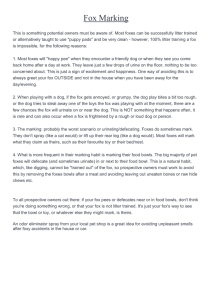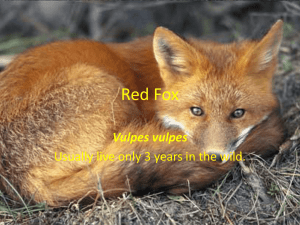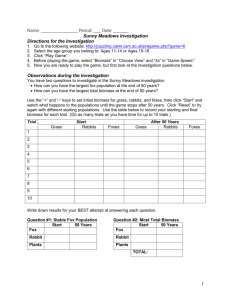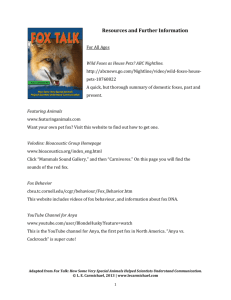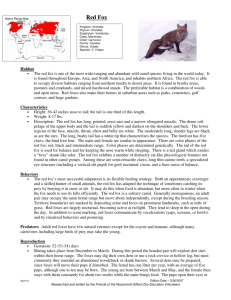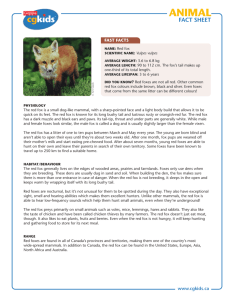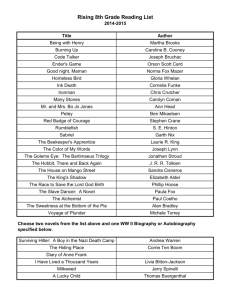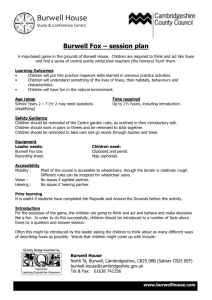Key Stage 2 - Red Foxes
advertisement
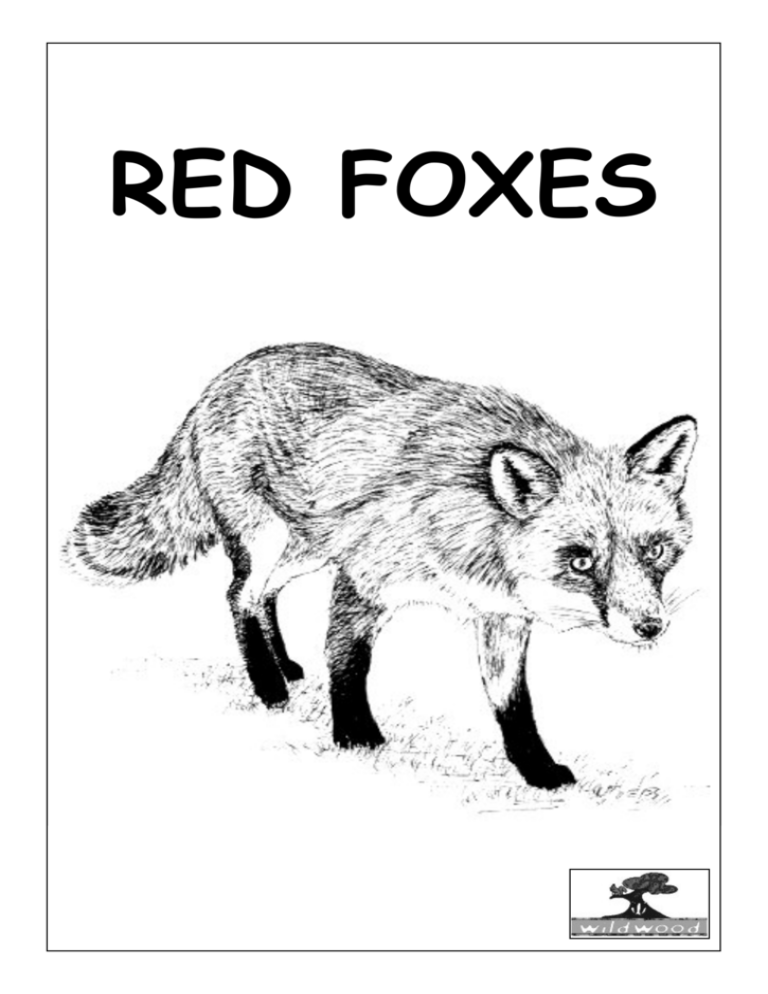
RED FOXES Teacher’s Notes Introduction The Wildwood Animal Workbooks for Key Stage 2 include Beavers, Badgers, Otters, Frogs, Owls, Red Foxes and Wolves. Each workbook follows a standardised pattern so that children can select different animals to study but still cover the same themes. The activity sheets are appropriate for use either as an introduction before a visit or as follow up work. Each activity sheet is designed to link in with and support National Curriculum Programmes of Study for different subjects, including Science, Literacy, Numeracy and Art. There are also Key Stage 1 workbooks covering the same animals to aid differentiation. Activity Sheets The following list gives details of the activity sheets contained in the workbook, including the relevant National Curriculum P.O.S and the learning objectives which each sheet covers. Adaptation 1 SUBJECT: Science P.O.S: Sc2 - Life processes and living things LEARNING OBJECTIVES: To understand that different animals are found in different habitats. To understand that animals are suited to the environment in which they are found. Food Chains and Teeth 2 SUBJECT: Science P.O.S: Sc2 - Life processes and living things LEARNING OBJECTIVES: To understand that most food chains start with a green plant. To identify the structure of a food chain of a specific animal. To identify important features of an animal’s mouth in relation to its diet. Teacher’s Notes Food Chains and Diet 3 SUBJECTS: Science & Maths P.O.S: Sc2 - Life processes and living things Ma4 - Processing, representing and interpreting data. LEARNING OBJECTIVES: To understand that different animals have different diets. To present evidence about foods eaten by an animal in a suitable bar chart. Habitats and Homes 4 SUBJECT: Science P.O.S: Sc2 - Life processes and living things LEARNING OBJECTIVES: To identify different types of habitats. Tracks and Signs 5 SUBJECT: Science P.O.S: Sc2 - Life processes and living things LEARNING OBJECTIVES: To identify foxes according to observable features. Human Impact and Conservation 6 SUBJECT: Science P.O.S: Sc2 - Life processes and living things LEARNING OBJECTIVES: To recognise ways in which living things and the environment need protection. Teacher’s Notes Myths and Legends 7 SUBJECT: English P.O.S: En2 - Myths, Legends & Traditional Stories LEARNING OBJECTIVES: To understand the difference between myths and legends and fact. Quiz 8 SUBJECTS: English & Science P.O.S: En2 - Reading for information Sc2 - Living things in their environment LEARNING OBJECTIVES: To scan texts to find information. The Wildwood Red Foxes 9 SUBJECTS: Art & design P.O.S: Exploring and developing ideas LEARNING OBJECTIVES: To record from firsthand observation. Life Cycle 10 SUBJECT: Science P.O.S: Sc2 - Life processes and living things LEARNING OBJECTIVES: To understand that adults have young and that these grow into adults which in turn produce young. Teacher’s Notes Activity 11 SUBJECT: English P.O.S: En2 - Reading strategies LEARNING OBJECTIVES: To recognise words and show understanding of their meanings. Activity 1216 SUBJECTS: Art & design & English P.O.S: Investigating and making art,craft and design En2 - Nonfiction and nonliterary texts. LEARNING OBJECTIVES: To develop control of tools and techniques in art and design. To understand the structural and organisational features of instructions. Glossary 17 SUBJECTS: Science & English P.O.S: Sc2 - Life processes and living things En3 - Spelling LEARNING OBJECTIVES: To develop understanding of scientific vocabulary. To have a secure understanding of the purpose and organisation of a glossary. Please note that throughout the pack, underlined words can be found in the glossary. Adaptation Anything Goes Red foxes are predators. They live in family groups but they usually go hunting alone. Foxes will eat lots of different kinds of food, not just meat. This means that they are adaptable; they can live in many different habitats. Foxes are the most common predator in Britain. Large ears: Foxes have very good hearing to help them find their prey at night. Thick coat: woolly underfur and waterproof guard hairs on the outside keep the fox dry and warm. Long legs help the fox to jump and run fast. Long, sensitive whiskers Powerful jaws and sharp teeth for grabbing and killing their prey. Sensitive nose: a fox’s sense of smell is much better than a human’s. Even if they can’t see or hear their prey, they can smell it. A fox’s whiskers give it an important extra sense. When a fox wants to get through a small gap, it puts its nose in first. If its whiskers touch the sides of the hole, the fox knows that its body won’t fit through. Question: Foxes have eyes at the front of their heads. How do you think this helps them catch their prey? --------------------------------------------------------------------------------------------------- 1 Food Chains Teeth Food Chains and Teeth Can you draw and fill in the gaps of this simple food chain? Plant Herbivore producer Carnivore consumer consumer Rabbit R_ _ _ _ _ Sun G_ _ _ _ Foxes have teeth which have evolved to eat meat. The teeth are different shapes with l small incisors for cutting l canines for tearing l carnassial teeth for shearing flesh Can you name the different types of teeth on these red fox skulls? 2 Food Chains Diet Feeding Time Red foxes have a very varied diet. They mainly eat small mammals such as mice, birds, insects, earthworms, fruit and berries. So even though red foxes are classified as carnivores, their diet is more like an omnivore’s. Red foxes eat different things at different times of the year. For instance, in the summer they eat lots of insects and in the autumn they eat lots of berries. Foxes that live in towns will visit gardens and bird tables for scraps. Foxes that live near the sea eat crabs and fish. If they find more food than they can eat, foxes store it in a safe place and eat it later. Foxes have a special way of hunting small mammals. They pounce on them and pin them to the ground before eating them. Percentage (fraction out of 100) of different types of food taken by one fox over one month. Numbers taken Worms Insects Berries Mammals Frogs Birds 60 15 5 13 2 5 Percentage of food taken Can you complete the bar chart below using the information from the table? (To help you, worm numbers have been done for you.) 60 55 50 45 40 35 30 25 20 15 10 5 0 Percentage of different foods taken by a fox over one month Worms Insects Berries Mammals Type of food taken 3 Frogs Birds Habitats Homes Habitats and Homes Foxes can live almost anywhere. This is because they are able to eat different kinds of food and live in different habitats. They are found all over Britain in towns as well as in the countryside. Foxes that live in towns are sometimes called urban foxes. Foxes may live on their own or in small family groups and usually sleep in a hole in the ground which is called a den or an earth. They can be awake at any time of day or night, but are particularly active at dusk and dawn. What is a fox’s home called? Territory and Scent Marking Foxes usually live in one particular place which they do not like to share with foxes that they don’t know. This is called a territory. Foxes can let another fox know that a territory is already taken by scent marking. Foxes scent mark by going to the toilet at the edge of their territory. They also have scent glands around their mouth and between their toes - this means that they usually leave a smell behind wherever they go! Foxes have a very good sense of smell and by sniffing the ground they can work out who lives nearby! This picture shows a red fox leaving a fox dropping, one way in which foxes scent mark. Question: Can you think of another animal that scent marks its territory? ----------------------------------------------------------------------------------- 4 Tracks Signs Tracks and Signs Foxes are very adaptable and are able to live in towns as well as in the countryside. They often live quite close to people and if you look very carefully you might find some signs of foxes in the area where you live. Earths Foxes often use burrows which have been made by other animals, such as badgers or rabbits. They will also dig their own holes. In towns they often make earths under garden sheds. Old trees are sometimes hollowed out or have spaces in their tree roots which might be big enough for a fox family. Foxes can also make their home next to railway lines - look out for them from the train. Fox tracks can be easily confused with dog tracks but fox tracks are usually longer and thinner and the pads are more spread out. Look for tracks in mud, soft sandy soil or snow. 5cm Tracks 4.5cm Fox poo Fox poo is usually left in places where other foxes will smell it easily, such as a tree stump or a stone. The foxes do this to mark their territory. Fox poo contains bits of whatever the fox has eaten, such as bones or fur. In the autumn, it may be coloured red or orange if the fox has been eating berries. Can you see any signs of foxes in our fox enclosures? Write down or draw a picture of any signs you see. 5 Human Impact Conservation Foxes and Humans Urban Foxes These are foxes that live in towns. They have only become common since the Second World War. This is because houses and roads have been built on the fields and woods where foxes lived but the foxes haven’t moved away they’ve learned to live near people and buildings. Are urban foxes a pest? Foxes don’t cause too much disturbance in towns. They do not raid dustbins because they can’t open wheelie bins and they are not strong enough to push a dustbin over. They very rarely eat pets but if you have rabbits or chickens and there are foxes in your area, make sure they are kept secure at night. However, foxes can dig up flower beds, leave droppings on lawns and make a noise at night! This means that some people do not like having foxes as neighbours. Would you? This urban fox made friends with people at the station Should you feed foxes? Urban foxes are not starving and have plenty of food available to them. However, if you are lucky enough to have foxes visiting your garden, rather than feed them meat it is better to give them a scatter feed of nuts and raisins. This will take them a long time to eat and means that you won’t get too many foxes living in your area. Fox Hunting Fox hunting has been popular for more than 250 years and began as entertainment for the upper classes. When animals like the wolf and wild boar became extinct in Britain, hunters looked for a new animal to hunt. Foxes could run fast enough and far enough to provide a good chase for dogs and riders. Before the hunt earths and other holes were blocked to prevent the fox escaping down one of them. The official fox hunting season began on November 1 and finished in April. In 2004 a law was passed in England which banned hunting foxes with dogs. People are still allowed to chase foxes but the dogs are not allowed to kill them. Hunting with dogs was banned because a lot of people thought it was unfair and cruel for the fox. What do you think? 6 Myths Legends Fox Myths and Legends Foxes appear in many stories from all over the world because they are such a common animal. In lots of stories the fox is a very cunning character. In fact, in many tales from medieval times, the fox symbolizes the devil because it is so cunning and crafty. l Foxes were once believed to catch hedgehogs by weeing on them to get them to unroll! l People used to think that foxes had a very cunning way to get rid of fleas. The fox was supposed to take a piece of sheep’s wool in its mouth and walk slowly backwards into a pond. All the fleas would move onto its nose and then onto the piece of wool to escape from drowning. The fox then let go of the wool and the fleas floated away! l If there is a sudden shower of rain from a clear sky, a fox’s wedding is supposed to be happening somewhere. Medieval Medicine In medieval times, people made homemade cures for lots of things out of animal parts. Bits of foxes were used for all kinds of different cures: l Fox poo mixed with vinegar was supposed to cure leprosy. l Fox fat was rubbed into the scalp to try and cure baldness. l Eating a cooked fox tongue was believed to make shy people brave. l Finishing a bowl of milk started by a fox was supposed to cure whooping cough. Aesop’s Fables Fables are stories with a message, which are about animals acting rather like people. Foxes often appear in them. This is just one of Aesop’s fables that has a fox in it. The fox and the grapes One hot summer day the fox was walking through the orchard when he came to a bunch of grapes ripening on a vine. “This is just what I need to quench my thirst” he said. He jumped as high as he could, but he missed the grapes. He tried again and again to get the grapes as they looked very sweet and delicious. In the end, he got very tired and had to give up. He walked away with his nose in the air saying “I’m sure they are sour”. It’s easy to despise what you cannot get. 7 Quiz Fox Quiz 1. What is a fox’s home called? ------------------------------------------------------------------2. What kinds of food do foxes like to eat? ------------------------------------------------------------------3. What kinds of meat-eating teeth do foxes have? ------------------------------------------------------------------4. What do we call foxes that live in the town? ------------------------------------------------------------------5. What are female foxes called? ------------------------------------------------------------------- 8 Wildwood’s Foxes The Wildwood Foxes Red Foxes We have three red foxes at Wildwood. Foxes can be awake at any time of day but often the best times to see them are early in the morning or late in the afternoon. They do like to sunbathe, so look out for them snoozing in a patch of sunshine. Ellie and Chris live together in an enclosure near the shop. Ellie is a hand-reared female fox or vixen. Chris was a little orphan cub who was taken in by an organisation called the Fox Project. They rescue injured and orphaned foxes and look after them until they are well enough to go back to the countryside. They are very careful not to let the foxes get too tame and too used to people looking after them and bringing them food. However, sometimes one or two foxes do get too tame and then they can’t go back to the wild so they come to live at places like Wildwood. This is what happened to Chris. Our other fox is a vixen called Mo. She lives in an enclosure near the red squirrels. Mo is also a fox who was rescued by the Fox Project and was unable to be released back into the wild. She was very tame when she first came to Wildwood but now that she is old she is much more shy. Look out for her snoozing in her tower! Arctic Foxes There are two Arctic foxes at Wildwood. Arctic foxes are a different species and they do not live in Britain nowadays. Thousands of years ago, when Britain was much colder, Arctic foxes lived here. They have thick, fluffy, white coats in winter for warmth and camouflage in the snow. In summer they have much shorter, dark grey fur. Our Arctic foxes are a male called Alan and a female called Fleck. Have you seen any of our foxes Playing? Sleeping? Eating? Running? Choose your favourite Wildwood fox and use the box to draw a picture of it. 9 Life Cycle Fox Life Cycle Foxes usually live together in family groups. Males are called dog foxes, females are called vixens and baby foxes are called cubs. There is usually one dog fox and one vixen who are the leaders of the group. This vixen is normally the only one who has cubs. 1. The vixen looks for a safe place to have her cubs. They are usually born in spring. 5. Adult fox. Young foxes may stay with their parents or they may leave in the autumn and look for a new home. 2. The cubs are born blind and deaf, but with a short covering of fur. Their fur is grey at first and turns red when they are older. 4. The fox cubs come out of the earth in April or May. They learn hunting skills from their parents. 3. The cubs stay underground until they are a few weeks old. By the time they come outside, they are very playful. Question: Why doesn’t the vixen go hunting for food herself while the cubs are little? ----------------------------------------------------------------------------------- 10 Activity Red Fox Word Search Can you find all the words to do with foxes in the grid below? There are 17, running forwards, backwards, up, down, across and diagonally. Some of the letters are used in more than one word. To help you, here are some clues for the words you are looking for: V_ _ _ _, a female fox, C_ _, a baby fox, E _ _ _ _, a fox den, R _ _ _ _ _, M _ _ _, V _ _ _ _, I _ _ _ _ _ _, food for foxes, C _ _ _ _ _ _ _ _, a meat- eater, P _ _ _ _ _, a fox does this to catch its prey, T _ _ _, foxes sometimes live here, B _ _ _ _, another word for a fox tail, T _ _ _ _ _ _ _ _, an area where a fox lives which it defends from other foxes, F _ _, this keeps a fox warm, T _ _ _ _ _, a fox might leave these in mud or snow, C _ _ _ _ _ _, sharp teeth used for killing prey, P_ _, a fox foot, S _ _ _ _, what a fox does with its nose. C A R N I V O R E T L P A W N P A B E R B O T O S X C R B A T U I T E A R U Y C S N B E C I M S N K L C B L T U V H E S 11 L E A O S C B P X R E A R T H K H M I U M Y V N S E L O V F S M E S E N I N A C Art Make a Fox Finger Puppet! To make your finger puppet, you will need: an Actimel or yoghurt drink pot a pair of scissors some glue felt tips l l l l 1. Colour in the shapes on the following page in fox colours. 2. Cut out the plain rectangle and glue it on to an Actimel pot to make the body of your fox. 3. Cut out the head and draw on eyes and a black nose. 4. Cut out the small strip and glue it to the back of the head. Leave a piece sticking out and glue this to the top of the pot. 5. Cut out the striped rectangle and cut along the lines to make a fringe. 6. Roll up the fringed rectangle to make a bushy tail. Glue the solid part to the bottom of the pot at the back. 12 Art 13 Art Make a Red Fox Mask! To make your mask, you will need: l l l l crayons or coloured pencils a pair of scissors sellotape or glue some thin elastic 1. Cut out the fox face and fox muzzle. Make sure you don’t cut off the tabs! 2. Colour in the face and the muzzle. Ask a grown-up to help you cut out the eye holes. 3. Cut the 3 slits in the face and push the tabs through them. Fasten with sellotape or glue. 4. Measure the correct length of elastic to fit around your head. 5. Make two small holes in either side of the mask. Thread the elastic through and tie a knot. 6. Your mask is now ready to wear! 14 Art 15 Art 16 Glossary Word List l l l l l l l l l l l l l l l l l l l l l adaptable - able to respond quickly to change. canine - fang-like teeth at the side of the mouth, often used for stabbing and holding prey. carnassial - sharp, triangular, scissor-like teeth used for slicing up food. carnivore - an animal which eats meat. carrion - dead animals. consumer - an animal which eats plants or other animals. Consumers are sometimes called carnivores or omnivores. dog fox - a male fox. guard hairs - the tough wiry hairs that form the outer layer of an animal’s fur. habitat - a place where an animal lives. incisor - rectangular-shaped teeth at the front of the mouth usually used for cutting. mammal - animals which have fur, give birth to live young (they don’t lay eggs) and produce milk to feed their young. omnivore - an animal which eats both meat and plants. predator - an animal which hunts and eats other animals. prey - an animal which gets hunted and eaten by other animals. producer - a green plant which can take energy from the sun and make food using the process of photosynthesis. scent gland - a part of the body which produces a smelly oil. scent marking - when an animal using its scent glands to leave its smell on objects or other animals. territory - a place where an animal lives, which it defends from other animals. urban - lives in a town. underfur - a layer of fur underneath the guard hairs, often soft and fluffy so that it keeps the animal warm. vixen - a female fox. 17
